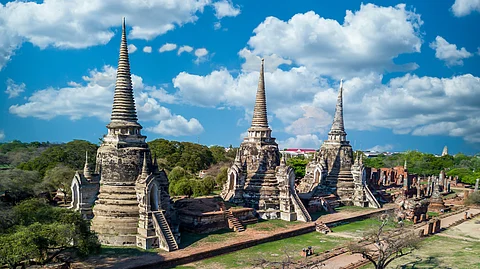

Ayutthaya, about 89 km north of Bangkok in Thailand, was the historical capital of Siam. Ramathibodi I, also known as King U Thong, is said to have founded the town around AD 1350 on an island formed by the confluence of the Chao Phraya, Lop Buri, and Pa Sak rivers. Thailand's modern state may be traced back to the creation of Ayutthaya, whose numerous rulers increased their powers to make their realm one of the most powerful in Southeast Asia.
Ayutthaya was the Siamese Kingdom's second capital. From the 14th to the 18th century, it grew, becoming one of the world's largest and most cosmopolitan cities, as well as a centre of global diplomacy and commerce. In 1767, the Burmese army stormed and burned the city. The city was never reconstructed in its original location and is now known as a vast archaeological site. It is currently located in the Phra Nakhon Si Ayutthaya District of the Phra Nakhon Si Ayutthaya Province.
Ayutthaya is now an archaeological ruin with numerous temples and other historical and architecturally significant sites. The area is distinguished by the remnants of tall prang (reliquary towers) and stunning Buddhist monasteries which offer an indication of the city's historical scale and architectural splendour. The Ayutthaya Historical Park encompasses the ruins of the old city of Ayutthaya in Thailand's Phra Nakhon Si Ayutthaya Province. In 1991, a portion of the park was designated as a UNESCO World Heritage Site which encompasses an area of 289 acres.

The temple, located at the northern end of Si Sanphet Road in the Phra Nakorn Si Ayutthaya district, is not only a major historical site but also a spiritual centre for Thais. This was the largest temple in Ayutthaya during its peak and was used to hold royal court functions once. The ashes of three Ayutthaya monarchs are housed in the three principal chedis that have been repaired.
Also known as the Monastery of the Royal Repairs, the temple was most likely enclosed by a moat in ancient times. The water was a metaphor for the oceans that surrounded Mount Meru (represented by the prang). It was built in the Khmer style and is similar to the structures at Angkor. Only the royal vihara's walls and foundations remain today. Of particular note are the surviving mural paintings in the crypt.

Located to the east of the Grand Palace, adjacent to Pa Than Bridge. Wat Mahathat is thought to be one of the earliest and most important temples in Ayutthaya's history because it housed the Buddha's sacred relic. Many important royal rituals from the Ayutthaya period were held here. Fire extensively damaged and destroyed Wat Phra Mahathat. You can see the remains of some pagodas, royal halls, temples, murals under a Bodhi tree, and the famous sandstone Ayutthaya-style head of the Buddha in the root of a tree.

Wat Yai Chaimongkhon, also known as Wat Chao Phraya Thai, is a monastery built during the time of King U-Thong. Its enormous pagoda may be seen from afar. It is said that King Naresuan the Great ordered the construction of the pagoda to commemorate his single-handed victory on the back of an elephant. The Phra Chedi Chaimongkhon here was built under the orders of King Naresuan the Great as a memorial for his victory over King Maha Uparacha of Burma.

Time Required
It takes at least a full day, if not two, to thoroughly explore the UNESCO World Heritage Site of Ayutthaya. You can rent a cycle from bike rental shops here. Or you can hire a tuk-tuk for the day.
Dress
It is recommended that you follow a dress code recommendation for Buddhist sites like Ayutthaya, essentially shoulders must be covered. Wear bottoms that cover the knees.
Entry
While entry to Ayutthaya Historical Park is free, some temples and sites in the park have individual entrance fees.
The nearest airport is Bangkok. From there, you can take a bus - the journey is around 1 to 1.5 hours. The trains from Bangkok to Ayutthaya take from 50 minutes to about 75 minutes.
